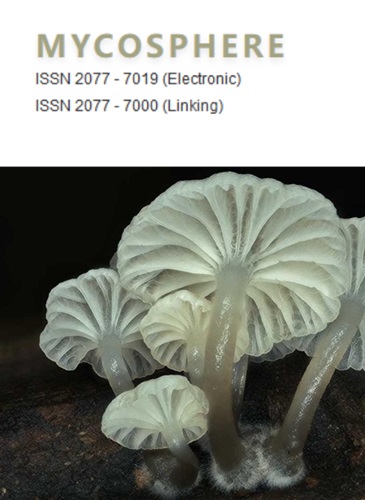多孢子菌精科:多孢子菌科和多孢子菌科
IF 15.1
1区 生物学
Q1 MYCOLOGY
引用次数: 117
摘要
dothideomyetes是真菌中最大和生态最多样化的一类,包括内生菌、附生菌、腐殖菌、人类和植物病原体、地衣和地衣、捕获线虫和栖息岩石的分类群。本纲成员的主要特征是双舌舌具裂裂裂裂,在水生和陆生生境中广泛存在。自2013年最后一部多壁菌科专著出版以来,陆续发现了许多新种、新属、新科、新目。这扩展了信息,导致了dothideomycates的现代分类。本文以多孢子菌科和多孢子菌科为重点,对多孢子菌科进行了精细化的更新。我们分别接受多孢子菌科和多孢子菌科3目25科和4目94科。在多孢子亚纲中引入了副气孔科。每个科都提供了更新的描述,注释,包括代表形态的数字,已接受的属列表以及经济和生态意义。基于LSU、SSU、rbb -2和tef1序列数据的综合分析,构建了Dothideomycetidae和Pleosporomycetidae各目的系统发育树。提供了包括真菌科和畸形球科等几个属的科的家谱。介绍了两个新属(Ligninsphaeriopsis和parophiostoma)。在形态学和系统发育方面,介绍了5个新种(双翅蛾、半盖蛾、泰国木脂虫、泰国副蛇孔虫和泰国虎),以及9个新报道和7个新收集本文章由计算机程序翻译,如有差异,请以英文原文为准。
Refined families of Dothideomycetes: Dothideomycetidae and Pleosporomycetidae
The class Dothideomycetes is the largest and most ecologically diverse class of fungi, comprising endophytes, epiphytes, saprobes, human and plant pathogens, lichens, and lichenicolous, nematode trapping and rock-inhabiting taxa. Members of this class are mainly characterized by bitunicate asci with fissitunicate dehiscence, and occur on broad range of hosts in aquatic and terrestrial habitats. Since the last monograph of families of Dothideomycetes in 2013, numerous novel species, genera, families and orders have been discovered. This has expanded information which has led to the modern classification in Dothideomycetes. In this paper, we provide a refined updated document on families of Dothideomycetes with emphasis on Dothideomycetidae and Pleosporomycetidae. We accept three orders with 25 families and four orders with 94 families in Dothideomycetidae and Pleosporomycetidae, respectively. The new family Paralophiostomataceae is introduced in Pleosporales. Each family is provided with an updated description, notes, including figures to represent the morphology, list of accepted genera, and economic and ecological significances. We also provide an overall phylogenetic tree of families in Dothideomycetes based on combined analysis of LSU, SSU, rpb-2 and tef1 sequence data, and phylogenetic trees for each order in Dothideomycetidae and Pleosporomycetidae. Familylevel trees are provided for the families which include several genera such as Mycosphaerellaceae and Teratosphaeriaceae. Two new genera (Ligninsphaeriopsis and Paralophiostoma) are introduced. Five new species (Biatrisopora borsei, Comoclathris galatellae, Ligninsphaeriopsis thailandica, Paralophiostoma hysterioides and Torula thailandica) are introduced based on morphology and phylogeny, together with nine new reports and seven new collections from
求助全文
通过发布文献求助,成功后即可免费获取论文全文。
去求助
来源期刊

Mycosphere
MYCOLOGY-
CiteScore
30.00
自引率
8.20%
发文量
9
审稿时长
4 weeks
期刊介绍:
Mycosphere stands as an international, peer-reviewed journal committed to the rapid dissemination of high-quality papers on fungal biology. Embracing an open-access approach, Mycosphere serves as a dedicated platform for the mycology community, ensuring swift publication of their valuable contributions. All submitted manuscripts undergo a thorough peer-review process before acceptance, with authors retaining copyright.
Key highlights of Mycosphere's publication include:
- Peer-reviewed manuscripts and monographs
- Open access, fostering accessibility and dissemination of knowledge
- Swift turnaround, facilitating timely sharing of research findings
- For information regarding open access charges, refer to the instructions for authors
- Special volumes, offering a platform for thematic collections and focused contributions.
Mycosphere is dedicated to promoting the accessibility and advancement of fungal biology through its inclusive and efficient publishing process.
 求助内容:
求助内容: 应助结果提醒方式:
应助结果提醒方式:


